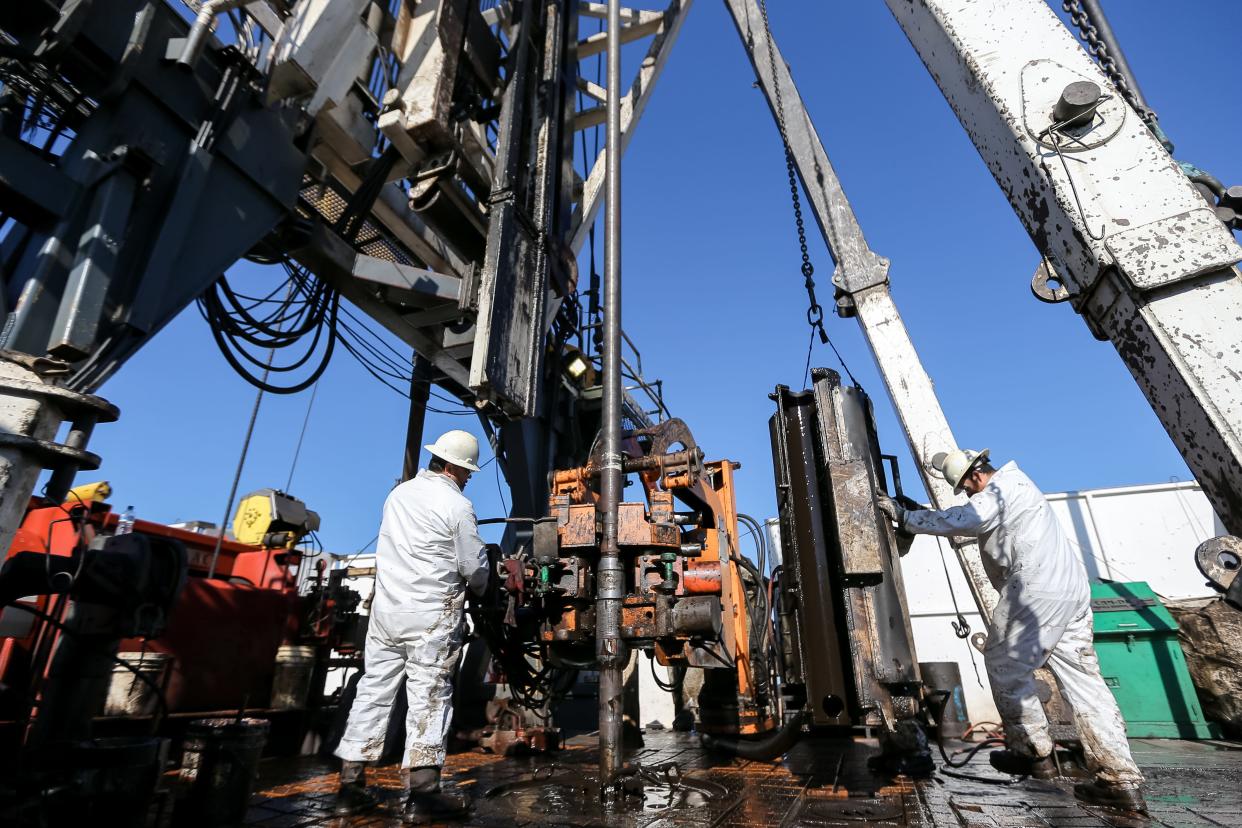How are Oklahoma's oil and gas companies faring amid market volatility?

Some Oklahoma energy companies are once again focusing on investor payouts as the number of active drilling rigs fell over the past year.
According to Baker Hughes' North America Rig Count, there are 20% fewer active rigs in the United States compared to a year ago. The market price of crude oil is roughly the same price as this time in 2023.
And in October, the United States broke its historical record for most barrels of oil produced in one month.
Oklahoma City-based oil and gas companies started 2023 with billions of dollars in profits, with plans to return much of that value to shareholders. It echoed a strategy revealed the previous year when companies refused to increase production even as oil prices climbed to 10-year highs.
Domestic energy companies faced criticism in 2022 for not ramping up supply to try to mitigate the loss of Russian oil and gas to western markets. The publicly traded companies, which have seen boom-and-bust cycles and a souring by some on investing in fossil fuels, mostly stuck to their plans for rewarding the shareholders who stuck with them.
"(Energy) companies have already reduced debt and taken expenses out of the exploration and production process," said Jake Dollarhide, CEO of Longbow Asset Management. "I think all the low-hanging fruit has been picked off the tree in that regard, so I don't think operators can become any more efficient than they already have been. So the question is, what's the best use of cash?"
Stock buybacks, he said, is one of the easiest ways to make a company more attractive to potential investors and reward those who've already pumped cash into the operation. With fewer shares on the open market, a company can devote more money to paying dividends.
"Dividend-paying companies get a leg up most times when it comes to the average investor," Dollarhide said.
Devon Energy
In a call with industry analysts in November, Devon Energy CEO Rick Muncrief noted that oil production volume in the United States softened after the summer months.
"These constraints were temporary and have a visible pathway to correction with the industry's ongoing buildout of infrastructure," Muncrief said.
Despite that, Devon isn't planning to increase its own production for the market's sake.
"With ongoing macro-uncertainty, and with the ample spare capacity that OPEC+ possesses, we have no intention of adding incremental barrels into the market at this point in time," Muncrief told investors, referring to the cartel of oil-producing nations that influences global energy prices.
The company hopes to funnel 70% of profits to investors, either in the form of stock buybacks or dividend payments. Devon has about $900 million left, out of an original $3 billion, to repurchase shares.
Shareholders received a dividend in November worth $0.77 per share. The company expects to retire $1 billion worth of debt over the next two years.
Sandridge Energy
The quarterly report for Sandridge Energy was more muted, with the company offering shareholders a dividend of $0.10.
Sandridge reported profits of over $16 million in the third quarter and told investors it would play "small ball" in the coming year when it comes to developing new wells or reactivating those that have sat idle.
CEO Grayson Pranin said during the company's most recent earnings call that he would have to see prices increase beyond $80 per barrel for crude oil or $4 per unit of natural gas before expanding operations.
As of Wednesday, West Texas Intermediate (WTI) crude oil was trading at $72, and natural gas on the Henry Hub market has remained under $3 since November.
Sandridge might take advantage of lower prices if they persist, however. Pranin said the company would evaluate merger and acquisition opportunities in 2024.
"The lower natural gas and (natural gas liquids) price environment, down from the previous year's highs, could present more cost-effective opportunities for acquisitions, which could then be positioned to capitalize on future price improvements," Pranin said.
Continental Resources
Continental Resources recently finished its first year of being a privately held company after 15 years on the stock market. In late 2022, founder Harold Hamm and his family repurchased $4.3 billion worth of shares and retook full control of the company.
Even though it's now privately held, Continental still filed its quarterly report in November to comply with debt requirements. In its report, Continental reported acquiring $681 million worth of property and selling another group of properties for $377 million.
Continental had a net income of over $370 million in the third quarter and ended up with about $50 million cash on hand.
Chesapeake Energy
Chesapeake Energy Corp. also promised investors that by December, it would pay $0.57 per share as a dividend. The company also had $600 million on hand out of an original $2 billion to repurchase shares.
The company reported having over $700 million cash on hand as of September 2023.
During his quarterly earnings call in November, Chesapeake CEO Nick Dell'Osso described how the company has improved efficiency in its natural gas production and transmission.
Chesapeake planned to finish the year with an additional 2.5% worth of production. Dell'Osso told investors that the company would keep its rig count at nine during the first half of 2024, but could add another drilling rig to the company's Haynesville operations in Louisiana later in the year.
This article originally appeared on Oklahoman: Oklahoma energy companies are returning profits to investors amid volatility

